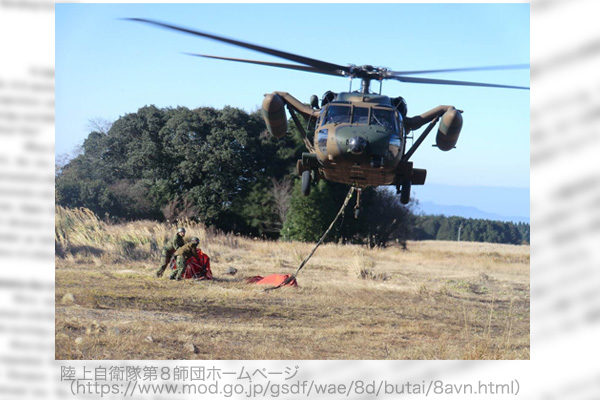On April 6, a UH-60JA helicopter of the Ground Self-Defense Force crashed in waters near Miyako Island of Okinawa Prefecture, killing all 10 crewmembers including Lt. Gen. Yuichi Sakamoto, Commander of the GSDF 8th Division. A photo on the Yomiuri Shimbun newspaper of the helicopter’s wreckage salvaged from the seabed shows a main rotor blade that was torn off and appeared to have pierced into the engine cover. Using flight recorder data reported on May 24 as a reference, I tried to consider the cause of the accident.
A similar accident in the past
Yahoo News carried a comment on April 23 that a breakage around the main rotor head, which caused the crash of a GSDF AH-64D attack helicopter in Saga Prefecture in 2018, should be suspected as a factor behind the latest accident.
According to the comment, a rotor head bolt was broken due to metal fatigue with a rotor blade torn off in the Saga accident, making the adjustment of the rotor angle impossible. Then, the rotor hit the airframe, triggering the crash almost immediately. There is a video showing the crash.
In some four months after the Saga accident, the GSDF estimated that a bolt for a component to fix the main rotor to the rotary shaft was broken. It suggested two possible causes of the bolt breakage: the abrasion of the bolt through the deterioration of the corrosion inhibitor and an original crack in the bolt. It fell short of identifying the cause of the bolt breakage. I would suggest metal fatigue as the third potential cause of the breakage.
Among metal fatigue, high-cycle fatigue that arises from about one million repetitions is a type of fatigue that causes cracks to expand and break instantly even with small loads of about one-tenth of the tensile strength of the metal. Past high-cycle fatigue cases include the damage to the fixing part such as bolts on rotary shaft, the damage to a weld for a large pump at Unit 3 of the Tokyo Electric Power Co.’s Fukushima Daini nuclear power station, the breakage of a tire hub for a large truck, the breakage of a wheel for a high-speed train in Germany and the rupture of a pressure bulkhead on a Japan Airlines aircraft. Regular inspection and maintenance of bolts and joints are important.
Make public flight recorder data
According to the Yomiuri Shimbun newspaper on May 24, the flight recorder of the crashed helicopter of the latest accident recovered from the seabed recorded a situation in which the engine of the aircraft made an abnormal noise and an alarm sound that notified the aircraft’s trouble. The captain and co-pilot were recorded shouting to maintain altitude while the engine output was decreasing. The aircraft is believed to have crashed into the sea immediately after that, and the voice stopped after the last voice saying “Ah”.
Assuming an event similar to the breakage of the rotor head bolt occurred at the UH-60JA helicopter, we can imagine what happened: First, there was a decrease in gas turbine engine output due to abnormal angle of the rotor blades. The broken rotor blade damaged the engine cover and generated abnormal engine noise. The remaining rotor blades hit the aircraft and caused it to crash.
Even if you try to identify the cause of an accident without knowledge of high-cycle fatigue, as in the 2018 accident, you may not be able to identify the cause and leave it as it is, and precious lives of SDF members including the division commander will be lost five years later. I would like the government to make public the flight recorder’s time-series data of aircraft abnormalities, engine output reduction, and crash, and share the data with the world to help ensure the safety of some 6,000 same-type helicopters in the world.
Tadashi Narabayashi is a specially appointed professor at the Tokyo Institute of Technology and a director at the Japan Institute for National Fundamentals.


